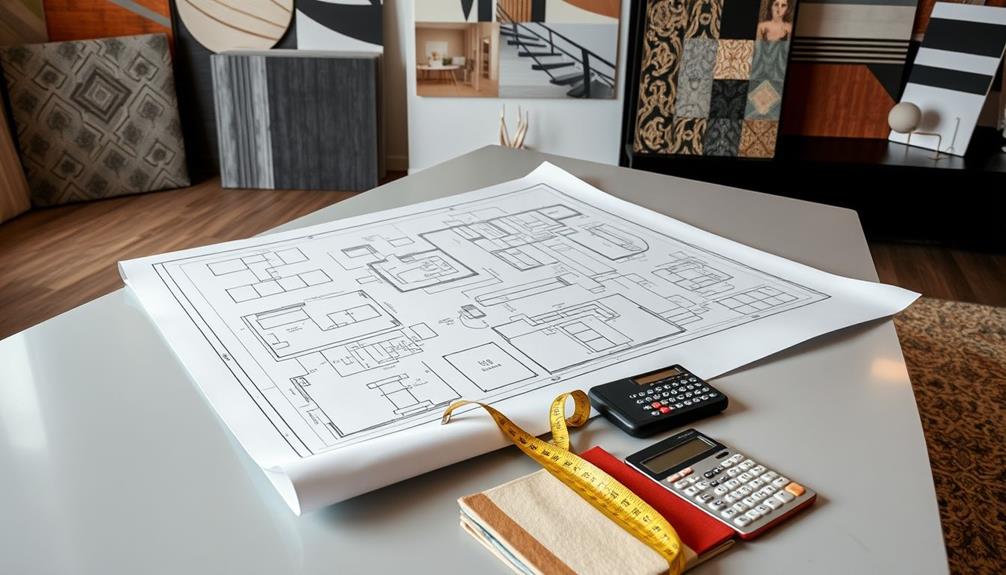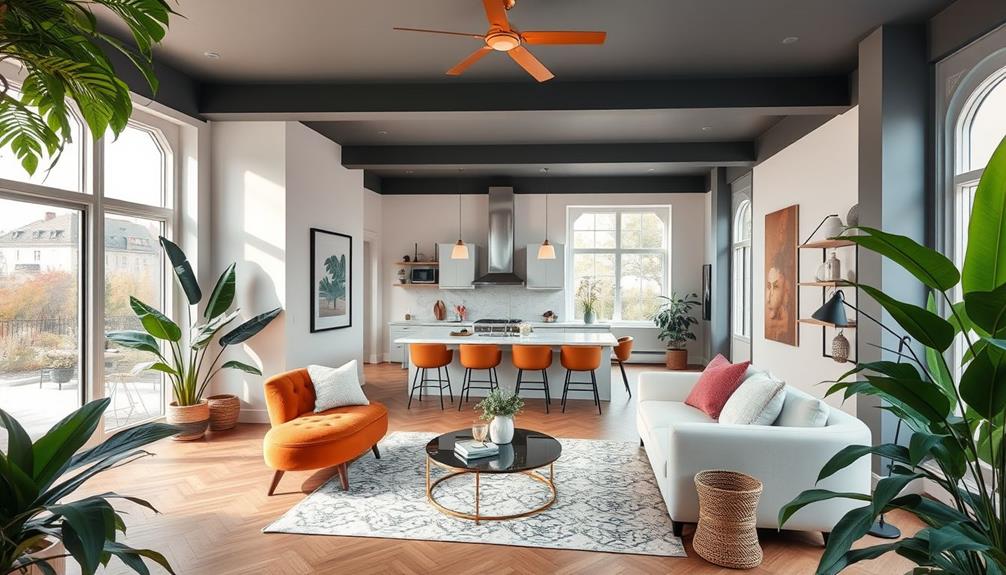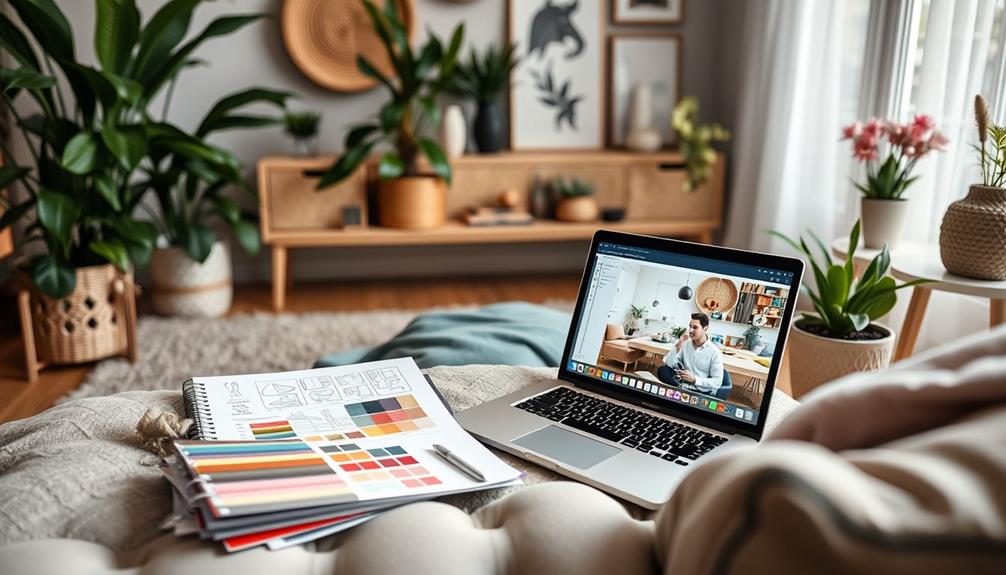When charging for interior design, you can choose from several pricing models based on your project and clients' needs. Options include hourly rates, which range from $75 to $250, flat fees for well-defined projects, or percentages of the total cost, typically 10% to 30%. You might also consider a price per square foot for commercial designs or a hybrid approach that combines flat fees with hourly charges for revisions. Each model has its own benefits, helping you establish clear expectations with clients. Keep exploring to discover the best fit for your service and style.
Key Takeaways
- Consider different pricing models such as hourly rates, flat fees, or percentage-based fees to align with project scope and client needs.
- Hourly rates offer flexibility and transparency, while flat fees simplify budgeting for well-defined projects.
- Pricing per square foot is effective for commercial projects, ensuring clear expectations on costs based on space measurements.
- Percentage-based pricing allows for adaptability but requires clear communication about fees to maintain client trust.
- A hybrid pricing approach combines flat fees and hourly rates, providing clarity and flexibility while enhancing client satisfaction.
Overview of Pricing Models
When deciding how to charge for your interior design services, it's vital to understand the various pricing models available. The most common options include hourly rates, flat fees, and hybrid structures. When charging for interior design services, you may choose to charge an hourly rate based on the amount of time you spend working on a project. This can be advantageous for projects with uncertain timelines or scope. Alternatively, a flat fee can provide more predictability for both you and your clients, especially for well-defined projects. Hybrid structures, such as a combination of hourly and flat fees, can also offer flexibility and transparency in billing for your interior design services. If you’re unsure about which pricing model to use, consider consulting with a business advisor or fellow interior designers to get their insights. Additionally, considering your target market and competitors’ pricing can help you set competitive rates. And once you have your pricing model in place, don’t forget to invest time and resources into marketing your interior design services. Consider leveraging social media platforms like Instagram to showcase your portfolio and provide valuable content, such as instagram marketing tips for interior design, to attract potential clients. This can help you build a strong online presence and reach a wider audience.
Hourly rates typically range from $75 to $250, depending on your experience and the project's complexity. This model allows flexibility but can lead to unpredictability in final costs.
Flat fee pricing, on the other hand, covers the entire project, making it easier for clients to budget. However, it's important to define the scope of work clearly to avoid misunderstandings.
Pricing per square foot is another option, often used in commercial projects, averaging between $5 to $17.
Additionally, percentage-based fees usually fall between 10% to 45% of the total project cost, with an average around 15% to 30%.
For long-term projects, a retainer model can provide steady income for you while offering clients budget control by paying a monthly fee for a set number of hours.
Regularly reviewing your pricing structures guarantees you stay competitive in the market and align with client expectations, ultimately supporting your business growth.
Hourly Billing Method

The hourly billing method offers flexibility and transparency for both interior designers and clients. By charging an hourly rate, which typically ranges from $75 to $250, you can adjust your fees based on your experience and the project's complexity. This model is particularly beneficial for smaller projects or those with unclear scopes, allowing you to adapt to clients' needs without a fixed commitment.
To avoid undercharging, it's vital to track your hours diligently. Clients are billed only for the actual time spent on their projects, so clear communication about expected hours and potential costs is significant. This helps avoid misunderstandings and enhances client satisfaction.
When using this billing method, make certain your contracts explicitly outline the fees, scope of work, and any limits on changes. This clarity will manage client expectations and protect your time investment.
Flat Fee Billing Method

A flat fee billing method can simplify the payment process for both you and your clients, providing a clear, agreed-upon price for your services.
This approach works best when you have an extensive understanding of the project scope and can accurately estimate the hours needed to guarantee profitability.
To maximize client satisfaction and avoid misunderstandings, consider these key elements:
- Defined project scope: Confirm both you and the client understand what's included.
- Clear agreement on revisions: Specify how many revisions are part of the flat fee.
- Installments: Structure payments with an upfront deposit and milestones.
- Perceived value: Reflect the quality of your design services in your pricing.
- Mutual expectations: Establish clear deliverables to foster a positive working relationship.
Price Per Square Foot

When considering the price per square foot for your interior design projects, it's important to understand how this calculation works and the potential benefits and drawbacks.
This method often suits commercial spaces best, where you can easily measure the area to be designed.
Let's explore the ideal project types for this approach and how to set your pricing effectively.
Calculation Methodology Explained
Charging for interior design services can often benefit from the price per square foot methodology, which offers a straightforward way to calculate costs. Typically ranging from $5 to $17 per square foot, this method varies based on project complexity and location.
It's especially popular for commercial projects, where square footage measurements simplify pricing.
To effectively implement this fee structure, you need a detailed scope of work that outlines what services are included and excluded. This clarity helps set expectations for your clients, allowing you to build trust and transparency.
Payments are often collected in installments based on project milestones, ensuring that your cash flow aligns with the progress of the project.
As you navigate pricing your interior design services, keep a close eye on market rates and competitor pricing to remain competitive while ensuring profitability.
Consider these emotional aspects when using this methodology:
- Clarity in costs brings peace of mind.
- Fair pricing strengthens client relationships.
- Transparency fosters trust and loyalty.
- Structured payments ease financial strain.
- Competitive rates attract more clients.
Using this approach can enhance your interior design business's success!
Pros and Cons
Weighing the pros and cons of the price per square foot model can help you decide if it's the right fit for your interior design business. One of the main advantages is its straightforwardness; clients can easily understand how costs correlate with the area being designed. This billing method typically ranges from $5 to $17 per square foot, making budgeting simpler for both you and your clients.
However, there are also downsides. The price per square foot can vary greatly depending on your experience, location, and the project's complexity. It's essential to provide a detailed scope of services to prevent misunderstandings about what's included in the fee.
Another pro is that payments are often collected in installments based on project milestones, which helps manage cash flow throughout the design process.
Yet, be aware that if the project scope changes or expands, it may lead to disputes over additional charges.
Ideal Project Types
Many interior design projects are well-suited for the price per square foot model, especially those in commercial spaces like offices, retail stores, and restaurants.
Charging in this manner typically ranges from $5 to $17, depending on complexity and location. This approach streamlines estimating design fees and guarantees both you and your clients have a clear scope of what to expect.
Clients appreciate the transparency that comes with a price per square foot model, as it helps them manage their overall budget effectively.
To maximize the benefits, you should outline the specific interior design services included per square foot. This clarity prevents misunderstandings and fosters trust.
Consider these ideal project types for this pricing model:
- Offices needing a cohesive look
- Retail stores aiming to enhance customer experience
- Restaurants desiring a unique ambiance
- Showrooms showcasing products effectively
- Commercial renovations with defined space measurements
Percentage-Based Pricing

Percentage-based pricing is a popular fee structure in the interior design industry, typically ranging from 10% to 25% of the total project cost. This approach offers flexibility for varying project scopes and clients' budgets, allowing you to tailor your fees according to the complexity of each project.
Since this structure doesn't require upfront payments, it provides clients with initial financial relief, encouraging commitment to the project.
However, it's crucial to reflect on the potential ethical concerns surrounding the designer's material selection. Higher project costs can inflate your profits, which may impact client trust if they're not fully informed. Clients should be aware that percentage-based pricing can lead to higher overall costs, making it one of the more expensive fee structures available.
To guarantee a smooth working relationship, clear communication about how the percentage fee structure correlates with project costs is important. Discussing your approach upfront helps prevent misunderstandings and maintains transparency throughout the design process.
Commission-Only Strategies

When considering commission-only strategies, it's vital to understand how these commission structures work and what they mean for your business.
While this model can offer higher earnings through product sales, it also comes with pros and cons that you need to weigh carefully.
Clear communication with clients about how commissions are determined is essential to building trust and ensuring their needs come first.
Understanding Commission Structures
Commission-only strategies offer a unique approach to pricing in interior design, where you charge clients a percentage of the total cost of products purchased through your services. This percentage typically ranges from 10% to 45%, depending on your project and reputation.
Understanding commission structures is essential for maintaining transparency with your clients, as it helps prevent misunderstandings regarding design fees and profit margins.
By embracing this model, you can create a steady income stream while ensuring your earnings are linked to the quality of the products you source. This strategy shines in retail-focused design services, allowing you to leverage trade discounts and markups on materials.
Consider these emotional benefits of a commission-only approach:
- Empowering clients to make informed choices
- Creating beautiful spaces that reflect their style
- Building trust through transparent pricing
- Fostering lasting relationships with clients
- Encouraging you to seek high-quality products
Incorporating a commission structure into your pricing model not only motivates you to deliver exceptional value but also aligns your success with your clients' satisfaction.
Pros and Cons
A commission-only strategy in interior design offers both advantages and drawbacks that can greatly impact your business and client relationships. By charging a percentage—typically between 10% to 30%—of the total cost of furniture and materials, you can benefit from a steady income stream, especially during larger projects. This model can lead to higher earnings, but it also poses challenges.
One significant drawback is the potential for conflict of interest. You might find yourself prioritizing higher-margin items over your client's budget or preferences, which can undermine client trust. Transparency regarding your commission rates is essential; if clients feel blindsided by undisclosed markups, dissatisfaction and ethical concerns may arise.
Additionally, commission-only strategies could limit your client base. Many clients prefer fixed or hourly rates, especially if they've smaller budgets, making it essential to reflect on how this model aligns with your target market.
Ultimately, while a commission-only approach can be lucrative, it requires a careful balance of transparency and client-centric decision-making to maintain trust and foster long-lasting relationships.
Client Communication Strategies
Successfully managing client communication in a commission-only strategy can make a significant difference in your business relationships. When you're transparent about how you charge a flat fee or a commission based on client purchases, you build trust.
Clearly explaining the commission structure—typically 10% to 30% of the purchase price—helps clients grasp potential costs and how they fit into their overall design budget. Additionally, leveraging architectural solutions can enhance your design offerings and strengthen client engagement.
To enhance client satisfaction, consider implementing these strategies:
- Be upfront about markup on products to show how it supports your expertise.
- Provide a detailed breakdown of commission fees alongside project costs to eliminate confusion.
- Keep clients updated throughout the design process about commission earnings and selections.
- Encourage open dialogue to address any concerns or questions they might have.
- Celebrate their choices—recognizing their input fosters a collaborative atmosphere.
With clear communication, you not only manage expectations but also reinforce the value of your design services. This approach can turn a simple transaction into a lasting partnership, ensuring clients feel confident and satisfied with their investment in your design.
Hybrid Pricing Approach

Flexibility is key in the ever-evolving world of interior design, and a hybrid pricing approach offers just that. By combining different billing methods, you can create a pricing structure that meets both your needs and your clients'.
With a flat fee for defined design services, you give clients clarity on costs upfront. However, as changes arise or additional revisions are needed, you can seamlessly switch to hourly pricing, ensuring that you're compensated fairly for your time.
This hybrid model not only helps in managing client expectations but also enhances client satisfaction. Clients appreciate knowing the project fee in advance, while still having the option for adjustments without feeling anxious about unexpected costs.
Moreover, implementing a hybrid pricing strategy can mitigate the risk of undercharging on complex projects. You establish a baseline fee while allowing for adjustments based on additional hours or revisions.
Additionally, this approach can improve your cash flow, as you collect upfront payments for flat fees and bill hourly as the project progresses.
Indicators for Price Increase

When evaluating whether it's time to raise your interior design prices, several indicators can guide your decision. Start by closely examining your workload and profitability. If you're feeling burnt out without seeing a corresponding financial gain, it's a clear sign that a pricing adjustment may be necessary.
Additionally, reflect on how trends in home design, such as the growing popularity of modern farmhouse decor trends, may influence client expectations and your services' perceived value. Also, contemplate your closing rate; if you're consistently converting 100% of client inquiries, demand is high, signaling it might be time to price your interior design services higher.
Regularly analyze market rates and competitor pricing strategies. If your prices are notably lower than the industry standard, you may be undervaluing your skills.
Here are some additional indicators to reflect on:
- Increases in overhead costs, like hiring new staff or expanding office space.
- Your hourly rate feels insufficient for the effort you're putting in.
- Client feedback indicates they perceive your services as high value.
- You're struggling to manage client expectations due to workload.
- Positive performance trends demonstrate growth in your business.
Enhancing Client Experience

A seamless client experience is vital to justifying your pricing and ensuring client satisfaction. To enhance this experience, start by implementing high-end service expectations that align with your fees.
Consider how astrology shapes personal confidence and self-image, as this can influence your clients' perceptions of value. By presenting transparent pricing, you provide clients with detailed explanations of your services and associated costs, fostering trust and reducing discomfort regarding fees upfront.
Utilize client experience templates to streamline your processes, ensuring professionalism and consistency throughout the design work. Regularly gather client feedback to pinpoint areas for improvement; this can lead to increased satisfaction and referrals.
Investing in team training is essential, as research shows that well-trained staff greatly boost overall client satisfaction scores.
Moreover, focus on the stages of material selection and project execution, ensuring clients feel involved and valued. By prioritizing these elements, you create a successful interior design journey that reflects both your expertise and your clients' desires.
When clients recognize the quality of service they're receiving, they're more likely to view your pricing as justified. Ultimately, enhancing the client experience not only leads to satisfied customers but also fosters long-term relationships that benefit your business.
Conclusion
In the world of interior design, your pricing model is like the foundation of a sturdy home—essential and defining. By understanding various methods, you can build a structure that reflects your value while enhancing your clients' experience. As you grow and evolve, don't hesitate to raise your prices, much like a tree reaching for the sky. Embrace the journey, and let your unique style and approach shine, creating spaces that resonate with both you and your clients.








